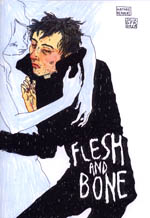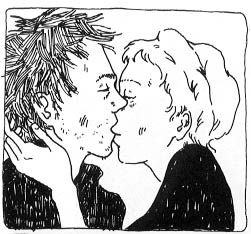 By Julia Gfrörer
By Julia Gfrörer
40 pages, black and white
Published by Sparkplug Comic Books
I’m cutting right to the chase here: Julia Gfrörer’s Flesh and Bone is a creepy, disturbing, comic. I mean that in a good way; Gfrörer mixes love, death, occult, and betrayal into a fascinating story that takes a simple starting point and then moves it down a dark and twisty road. If I had to try and compare Flesh and Bone to an existing comic, it would probably be Hellboy, but a story in which Hellboy himself never comes to save the day.
One of the things I liked almost instantly about Flesh and Bone is that Gfrörer provides a mild fake-out early on in terms of the protagonist of her comic.When a grieving man comes to Jadwiga’s cabin in the woods, it’s a fair assumption that he’s the main focus of the comic, visiting a witch to find a way to be rejoined with his dead love in such a way that doesn’t condemn him to Hell over a suicide. It’s a strange enough opening moment for a comic, but Gfrörer quickly twists expectations and makes Jadwiga the protagonist of the story, the one who drives the story to its conclusion.  As we see the story unfold its pacing is interesting, Gfrörer taking time out to watch the sad man writhe in the grass at the graveyard for a page, or a sudden five-page conversation between Jadwiga and a lion-faced being in which she tries to justify her actions up until this point as well as laying groundwork for what’s to come. It actually makes the book feel slightly off-kilter, subverting expectations and keeping you uneasy until its conclusion.
As we see the story unfold its pacing is interesting, Gfrörer taking time out to watch the sad man writhe in the grass at the graveyard for a page, or a sudden five-page conversation between Jadwiga and a lion-faced being in which she tries to justify her actions up until this point as well as laying groundwork for what’s to come. It actually makes the book feel slightly off-kilter, subverting expectations and keeping you uneasy until its conclusion.
Gfrörer uses a wide mixture of mythologies, religions, and fairy tales in Flesh and Bone. From the initial idea about why the young man can’t simply kill himself to enter the afterlife to find his lost love, to the usage of mandrake root, Gfrörer’s drawing from different places works surprisingly well here. I can see why she takes the time to have Jadwiga talk to Baur about her plans toward the end of the book, so that readers can follow along with the final sequence of events and understand that it’s more than a random sexual moment. That said, it’s worth noting for readers that are faint of heart that Flesh and Bone does have several sexual scenes in it, although none of them are gratuitous or out of place. Gfrörer has all of them for a reason, and none are to titillate. With each one, the plot advances (although perhaps not in the way you would expect) and it’s a mature, well-played sequence of events.
 The art in Flesh and Bone is like a strange tangle of lines, coming together and then pulling apart. Some characters under Gfrörer’s pen are a tight cluster of cross-hatches and intricate pieces, providing a great deal of texture and detail for the reader. At the same time, others seem to be drawn with a minimal number of lines, in some cases with the lines seeming to barely touch one another, almost being held together through force of will on the part of both Gfrörer and the reader. It’s as if Edward Gorey and Liz Prince somehow collaborated on a comic, and the end result is striking. I was also impressed with how Gfrörer slightly changed her approach for the color cover, using shading to achieve in some spots where the black and white comic used just lines, and as much as I enjoyed the interiors of Flesh and Blood, there’s something about the reddish blotch on the man’s face that makes me want to see more color comics from Gfrörer down the line. It felt so real, especially with the contrast of the almost-scribbled colors of the woman holding him, that it begs for additional creations along these lines.
The art in Flesh and Bone is like a strange tangle of lines, coming together and then pulling apart. Some characters under Gfrörer’s pen are a tight cluster of cross-hatches and intricate pieces, providing a great deal of texture and detail for the reader. At the same time, others seem to be drawn with a minimal number of lines, in some cases with the lines seeming to barely touch one another, almost being held together through force of will on the part of both Gfrörer and the reader. It’s as if Edward Gorey and Liz Prince somehow collaborated on a comic, and the end result is striking. I was also impressed with how Gfrörer slightly changed her approach for the color cover, using shading to achieve in some spots where the black and white comic used just lines, and as much as I enjoyed the interiors of Flesh and Blood, there’s something about the reddish blotch on the man’s face that makes me want to see more color comics from Gfrörer down the line. It felt so real, especially with the contrast of the almost-scribbled colors of the woman holding him, that it begs for additional creations along these lines.
I see a lot of comics as a side benefit of writing comic reviews, and Flesh and Bone is one of those rare ones that didn’t just stick with me after reading, it demanded to be revisited and fully savored. This is the first comic I’ve seen from Gfrörer, but hopefully it won’t be the last.
